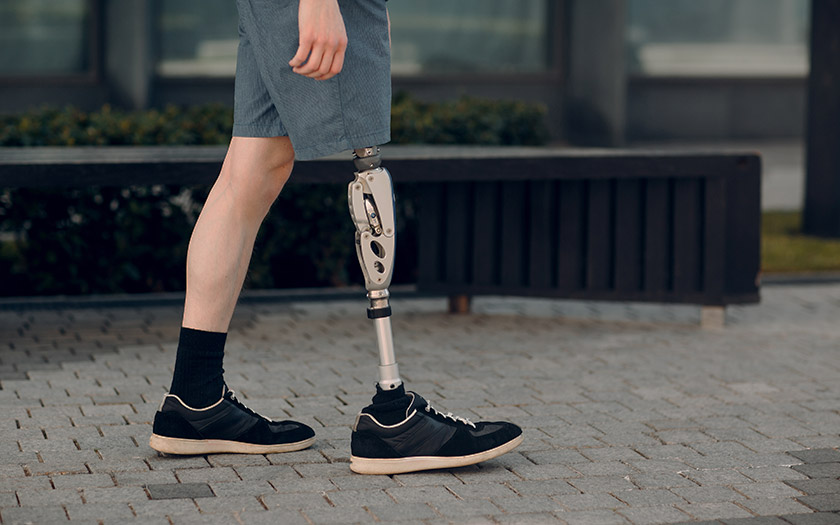The Way Forward In Lower Limb Prosthetics
“Compared to their predecessors, Adaptive Knees respond in real time and in an extremely reliable way”
Prosthetic technology has come a long way since the wood-leather prosthetic toe that dates back to 950-710 B.C. in ancient Egypt. Today, the use of materials derived from the aviation industry, microprocessors and gyroscopes from the technology and gaming industry and surgical inventions like Targeted Muscle Reinnervation (TMR) help thousands of amputees stretch the limits of their mobility every day.
The good news is that these advancements have crossed the boundaries of economically affluent regions and are also available for amputees in developing countries.
Adaptive Prosthetic Knees
Amputation levels at or above the knee joint mean significant loss of function. lithe knee function can be restored effectively, the user can assuredly go back to a near normal life.
The earlier version of prostheses used knee joints with springs and mechanical locks. Eventually, the use of pneumatics and hydraulics became very common in prosthetic knee joints and is prevalent till date. The hydraulic control was more sophisticated than the pneumatic control which in turn, was more sophisticated than spring control and proportionally allowed different degrees of functionality.
The year 1995 saw a new era in lower limb prosthetics. C-Leg the first fully Microprocessor-Controlled (MPC) knee prosthesis was introduced by Otto Bock Healthcare, a German manufacturer. And since 1995, at least twelve different variants of adaptive knees are commercially available and every year, a new manufacturer joins the bandwagon. In the USA alone, more than 30 per cent of above knee amputees use an Adaptive Knee.
What Is Meant By Adaptive?
What is so ‘adaptive’ about the MPG knees? MPG knees use sensors to adjust their mechanical response during swing and stance phases of walking. The image below describes how they do what they do :
Compared to their predecessors, Adaptive Knees respond in real time and in an extremely reliable way. For example, the current version of C-Leg MPG senses various parameters 100 times per second. They also allow the user to increase the sphere of their activities.
Like in the case of a man crossing a road. If he sees a vehicle approaching with speed, he needs to increase his own walking speed, at that moment. So the knee has to respond there and then, not wait to receive adjustments from the fitting prosthetist. Another classic example is safety. lithe user is in a trip-like situation , the microprocessor recognizes and stiffens the knee so that it does not buckle, allowing the intact leg time to recover. Various other functions like stair climbing, obstacle crossing, backward walking or walk to run are also made possible by the Adaptive Knees.
Benefits Of Adaptive Knees
In terms of actual functionality, Adaptive Knees otter many key benefits. In addition to enhanced mobility, they oiler a higher quality of lite and increase stability and confidence of the user. MPC Knees put the user in a more expedient position compared to non- microprocessor-controlled knees.
In India, the direct presence of MNCs working in the area of prosthetics and orthotics means that adaptive prostheses are also available here with the complete package of fitting by certified experts and follow-up support.
What Lies Ahead
Adaptive Knees have paved the way for development of adaptive feet and ankles and even integrated adaptive knee-ankle-foot systems. Some of these are commercially available in India as well. Powered prostheses which actually provide motorised propulsion are also available, but far from popular yet.
However, the real advancement in this area is going to be in control mechanisms – the adaptive prostheses with neural control whether myoelectric or brain-computer Interlace, or other modes. In India where living conditions are tougher than the developed countries like in the case of uneven roads, harsh weather, lack of supporting infrastructure etc. the need for adaptive prostheses is immense.
At present, the cost of adaptive prostheses is forbidding. However, concerted efforts towards private-public partnership and revamping healthcare funding and insurance policies can help more and more amputees access adaptive prostheses and become more productive members of society.
Members of a multidisciplinary rehab team in the country should work towards and look forward to the day when adaptive prostheses will become the standard care for amputees.
Types Of Prosthesis
- Transradial BE also known as a prosthetic forearm which is placed below the elbow.
- Transhumeral AE also known as a prosthetic lower and upper arm above the elbow which is inclusive of a prosthetic elbow.
- Transtibial BK also known as prosthetic lower leg which is attached below the knee to an intact upper leg.
- Transfemoral AK also known as prosthetic lower and upper leg above the knee which is inclusive of a prosthetic knee.
